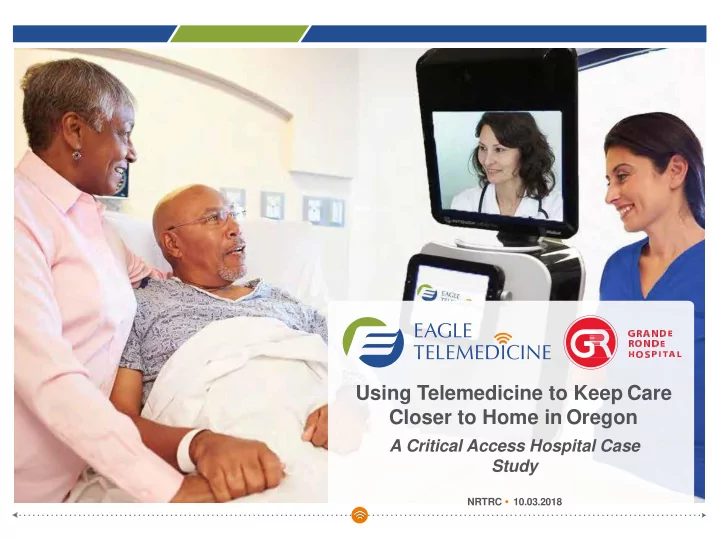

Using Telemedicine to Keep Care Closer to Home in Oregon A Critical Access Hospital Case Study NRTRC • 10.03.2018
Grande Ronde Hospital Mission We will ensure access to high-quality , cost-effective healthcare in a safe and customer-friendly environment for all those in need of our services 2
Grande Ronde Hospital At a Glance Grande Ronde Hospital is a private, not-for-profit, critical access hospital (CAH). Organization Facts & Figures Employees 762 Service Lines 20 Employed Providers 76 Ambulatory Clinics 14 Telemedicine Providers 95 RHC/Medical Homes 5 Gross Revenue $162M Service Area Population 51K Ambulatory/Outpatient $130M = Service Area Square Miles 10,596 Revenue 80% 3
Remote Presence Health System Outpatient Services/Clinics Consulting Services Other Services Cardiology Grand Cardiology Outreach Foreign Language Adult Hospitalist Outpatient Neurology Clinic Rounds Interpretation Services OHSU St. Alphonsus Idaho Heart Care Passport to Languages Eagle Hospitalist Physicians Televisit Medical Oncology Distance Education Outpatient Legacy Health System, Dr. M Bronstein, LA Adult Intensivists St. Alphonsus Endocrinology Portland, OR Grande, OR; SAMG; St. Advanced ICU Care Walla Walla, WA Clinic Alphonsus Emergency Congestive Heart Department Grand Televisit Left Ventricular Assist Telepharmacy Failure Teaching Providence Telemedicine Rounds Device Clinic St. Alphonsus Network, Portland, OR Idaho Heart Care Idaho Emergency OHSU Physicians Neonatology Televisit & NICU Teleradiology Genetic Counseling Televisit St. Alphonsus Telebaby Statrad St. Alphonsus Salem Hospital, Salem, OR St. Alphonsus Parkinson’s PICU Cardiology Acute Movement Disorders OHSU Myocardial Infarction Clinic Support Emergency Oregon Health & Science Specialist Program Rheumatology University (OHSU) Idaho Emergency St. Alphonsus, Baker City, Physicians OR Telestroke St. Alphonsus 4
ICU Tele-intensivist Experience 10 Years: CY2008-CY2018 138 ICU Patient Transfers Were Avoided $4,934,041 Estimated Transfer Cost Savings 138 ICU Patients Admitted Instead of Transferred 1,030 Additional ICU & MedSurg Days Significant Impact on Medicare Cost to Charge Ratio 64.6% Medicare ~ 5
Tele-oncology • The circumference of the earth at the equator is: 24,901 miles • Every 18 months our Tele-oncology program saves patients one trip around the earth. 25,434 miles In just the first nine days of April: 19 patients received chemotherapy 5,384 travel miles saved, 87 hours of travel time saved, and $3,042 in travel expenses saved! 6
Virtual Visits GRH ReadyCare Insurers Covering Virtual Visits • United HealthCare • Providence • Aetna 7
Remote Home Monitoring Potential Monitored Conditions • Patients with CHF and diabetes chronic conditions • They connect daily via remote monitoring CHF/Coronary Artery Disease/Atrial Fibrillation • Remote services are delivered via tablet device Ortho (Hip/Knee) COPD • Vitals are collected and stored in the cloud ~ Diabetes Asthma Hypertension Post-Transplant/Surgical Home Dialysis Hyperlipidemia Pneumonia Depression and Behavioral Health Comorbidities Adults/Pediatrics 8
Our Future Plans for Telehealth Expand in-home Expand Develop Work with AHA to monitoring teleneurology for outbound resolve Medicare program beyond deep brain ambulatory reimbursement congestive heart stimulation services: clinics, issues failure and monitoring and workplace, home diabetes device adjustment 9
Tele-hospitalist 385 Night Program Calls in Physician Locations August 2017 Tega Cay, South Carolina Lawrence, Kansas Services Warner Robbins, Georgia Night coverage Bet Shemesh, Israel Cross-cover call Paris, France Onsite coverage relief 10
PHYSICIAN'S PERSPECTIVE “Telemedicine is most effective when applied where physician resources are scarce and patient care is time sensitive. And it is providing hope to rural hospitals in an era when closure is a very real possibility unless new models of care are deployed.” -Dr. McCormick
OVERVIE W Using Telemedicine to Keep Care Closer to Home • How to evaluate their critical-access facilities to determine the types of telemedicine programs that are truly needed • Steps for implementing telenocturnist care using remote physicians and on-site night- charge nurses • How to develop tele-cross coverage between nighttime rounding and ED admissions during surges • Best practices for establishing collaborative care between remote physicians and NP/PAs
TELENOCTURNIST PROGRAMS FOR CAHs Telenocturnists eliminate toxicity innight coverage, a problem most critical access hospitals face. THE • The traditional approach to night coverage is using day hospitalists to CHALLENGE take night calls. However, this often leads to burnout, physician attrition, and makes nurses hesitant to call. • The other alternative is hiring a full-time nocturnist. Recruiting and retaining a nocturnist is difficult, not to mention expensive. With salary and benefits, a full-time nocturnist can cost in excess of $600,000. Three Models for Success: THE SOLUTION • Telenocturnists: Patients receive real-time diagnoses and treatment at night from expert telenocturnists who are “beamed in” to the hospitalvia videoconferencing technology • Tele-Cross Coverage: Take the burden of floor calls off yournocturnist team with face-to-face consults via videoconferencing technology. • NP/PA Backup: Telenocturnists participate in rounds via livevideo- conferencing, and are available 24/7 as a part of your clinical team.
IMPLEMENTATION Implementing a TelenocturnistProgram • Test (and retest) technology • Orientation sessions for staff • Mock run • Hands on deck for Go-Live • Regular communication o Weekly communication leading up to Go-Live o Continuous dialogue during Go-Live o Weekly communication through the first month o Tweak processes
SURGE PROTECTION How to develop tele-cross coverage between night ime rounding and ED admissions during surges Reduce Burnout, Increase Performance: In the nighttime care domain, telemedicine provides balance, easing the load for existing staff and ensuring that your standard of quality extends around the clock. It’s a seamless solution to the physician shortage that Eagle Telemedicine innovated, and one that is reducing toxicity of night coverage for ourhospital partners today. Surge Protection: Hospitalist overload and ED bottlenecks can happen at any time, but with Eagle, your hospital can access expert telehospitalists whenever you need assistance N I G H T S with patient admits.
Thank you for your interest! Dr. "Mac" McCormick Doug Romer President & , Eagle Telemedicine Executive Director Patient Care Services, 678.441.8507 Grande Ronde Hospital DIRECT 541.963.1460 404.281.1603 MOBILE DIRECT www.eagletelemedicine.com
Recommend
More recommend